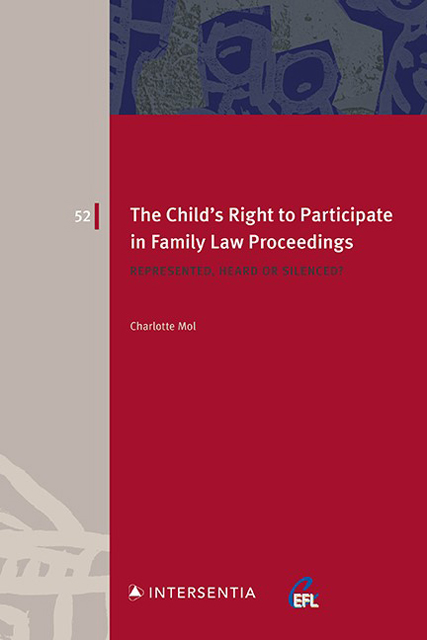Book contents
- Frontmatter
- Acknowledgements
- Contents
- List of Tables and Figures
- List of Abbreviations
- List of International and European Instruments and Sources
- List of Cases
- Chapter 1 Introduction
- Part I The Child’s Right to Participate in International and European Human Rights Instruments
- Part II The Child’s Right to Participate in The Case Law of the ECtHR
- Part III Comparative Remarks and Conclusions
- Appendix: Categorization of Cases Per Type of Proceeding
- Bibliography
- Index
- About the Author
- European Family Law Series
Chapter 10 - Comparison of the International and European Standards
Published online by Cambridge University Press: 20 April 2023
- Frontmatter
- Acknowledgements
- Contents
- List of Tables and Figures
- List of Abbreviations
- List of International and European Instruments and Sources
- List of Cases
- Chapter 1 Introduction
- Part I The Child’s Right to Participate in International and European Human Rights Instruments
- Part II The Child’s Right to Participate in The Case Law of the ECtHR
- Part III Comparative Remarks and Conclusions
- Appendix: Categorization of Cases Per Type of Proceeding
- Bibliography
- Index
- About the Author
- European Family Law Series
Summary
‘Le droit d’un enfant d’être entendu et de participer à la prise de décision dans une procédure familiale qui l’affecte en premier lieu est garanti par plusieurs instruments juridiques internationaux.’
– ECtHR, M.K. v. Greece (2018)Introduction
The child’s right to participate in family law proceedings is provided by multiple international and European human rights sources, as also recognized by the European Court of Human Rights (ECtHR) in the quote above. The cradle of the right to participate was the UN Convention on the Rights of the Child (UNCRC); subsequently in the European legal realm, the child’s right was mirrored in new binding instruments (the European Convention on the Exercise of Children’s Rights (ECECR) and the Charter of Fundamental Rights of the European Union (CFREU)) and soft law instruments (the Guidelines on Child-Friendly Justice (GCFJ) and the Recommendation on the participation of children). More interestingly, as Part II of this volume has shown, the child’s right to participation has also ‘come of age’ as a right under Article 8 of the European Convention of Human Rights (ECHR) through the case law of the ECtHR. These developments regarding the child’s right to participation over the past 30 years are an example of the ‘widening’ and ‘thickening’ of human rights. The adoption of new instruments, such as the ECECR and the CFREU, and the recognition of the right to participation in the case law of the ECtHR led to the ‘widening’ of the right at the international and regional levels. Through the widening, the right also thickens, as European states are now bound to provide for the child’s right to participation under multiple instruments. In other words, the accumulation of international and European human rights instruments addressing the child’s right to participate in family law proceedings has strengthened the right, but has also led to diverging interpretations of the right. The latter makes the comparison of these instruments an exciting endeavour.
- Type
- Chapter
- Information
- The Child's Right to Participate in Family Law ProceedingsRepresented, Heard or Silenced?, pp. 357 - 390Publisher: IntersentiaPrint publication year: 2022



